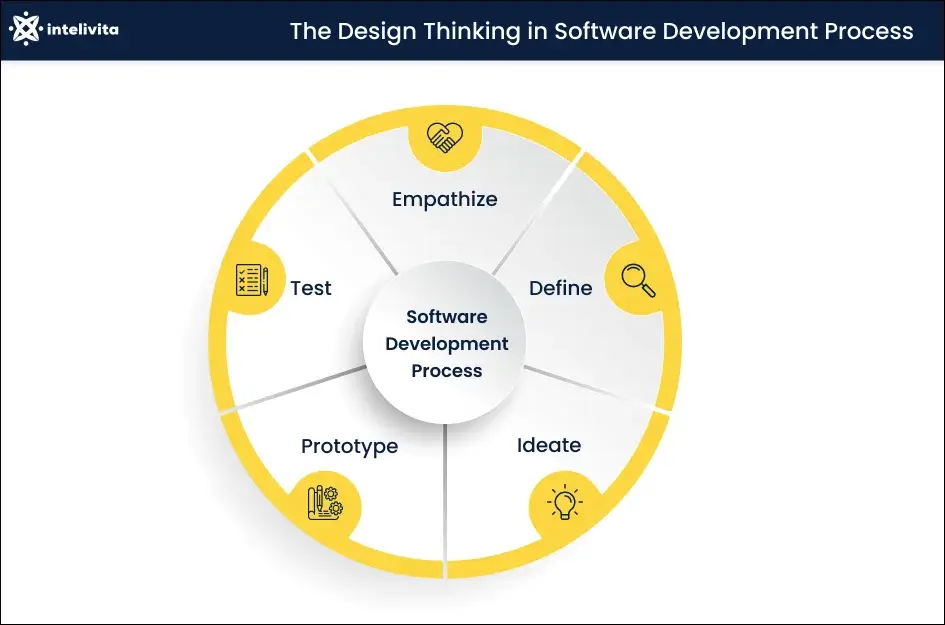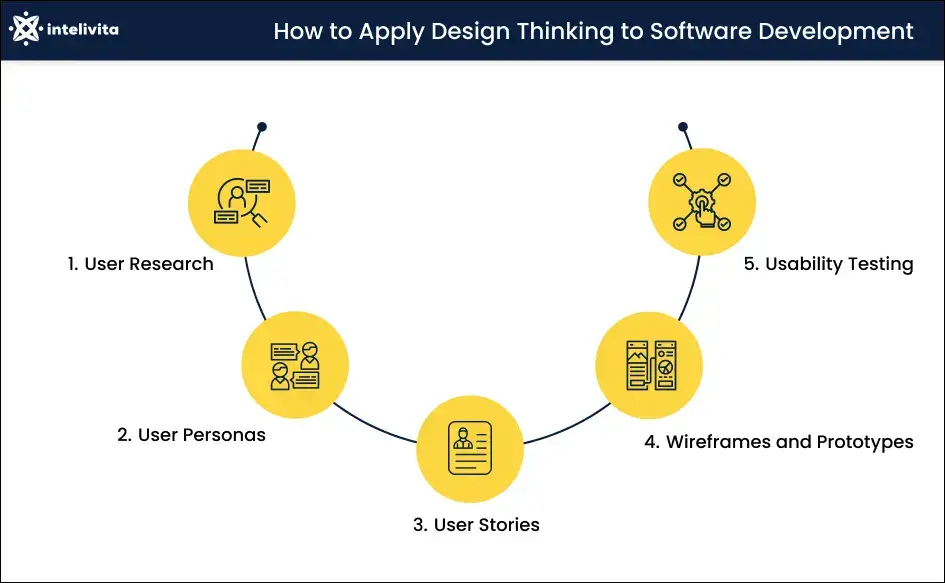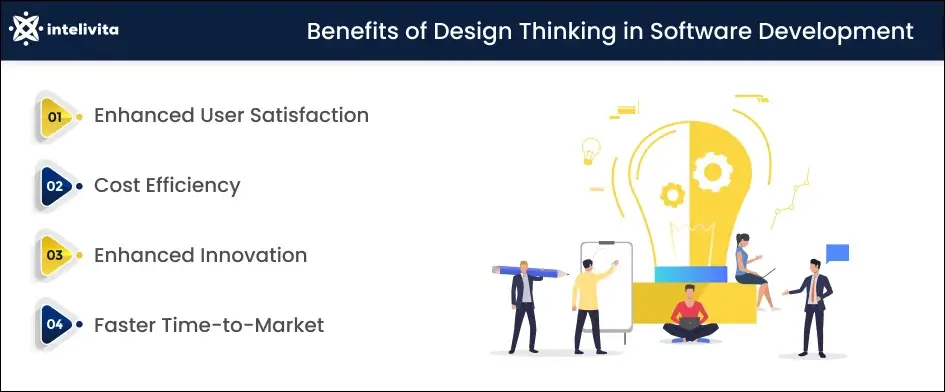Ever wondered why some software is easy to use and intuitive while others are not?
The answer might just be design thinking.
In 2032 the global software market expected to reach USD $1.78 billion, agility and responsiveness are essential to remain competitive.
Developers must create user-centered software quickly and efficiently.
Therefore, design thinking may be the solution.
This article explores the advantages of using design thinking in software development, offering practical tips for its implementation and challenges involved.
Let’s dive in!
What is Design Thinking Software Development?
Design thinking is a human-centered approach to problem-solving that can be used in a variety of fields, including software development.
It focuses on understanding the needs of users and developing solutions that meet those.
Design thinking is important in software development because it helps developers to create products that are both user-friendly and effective.
For example, making the “yes” button green instead of red is a simple but effective example of design thinking.
Green is often associated with positive things, such as success and growth.
Red, on the other hand, is often associated with negative things, such as danger and error.
By making the “yes” button green, developers can make it more likely that users will click on it.
The Design Thinking in Software Development Process
Design thinking principles in the software development lifecycle consists of five key stages.
Let’s explore them below.
1. Empathize
In this initial stage, developers aim to understand users deeply.
They gather insights into users’ needs, desires, and challenges. This understanding forms the foundation for the entire design process.
For example, when creating a mobile banking app, developers empathize by interviewing users to learn their essential features, financial management challenges, and security and ease of use expectations.
2. Define
After gaining a comprehensive understanding of users, the next step is to define the specific problem that needs solving.
This phase narrows the focus on what the software should address and the user pain points it should alleviate.
Take a mobile banking app project as an example.
The defined problem could be ensuring that users can easily transfer money between accounts while maintaining a high level of security.
This problem statement guides the design and development process.
3. Ideate
This stage encourages developers to brainstorm and generate as many potential solutions to the defined problem as possible.
The emphasis is on creativity and thinking outside the box.
During the ideation phase of the mobile banking app project on the example above, developers might brainstorm various ways to enhance the money transfer process.
This may involve using biometric authentication, QR codes, or integration with popular payment platforms.
4. Prototype
With a range of ideas in hand, developers create prototypes.
These are simplified, early versions of the software that allow them to test and visualize their ideas.
Prototypes can range from basic sketches to interactive digital models.
For the mobile banking app, developers might create a prototype that lets users simulate the money transfer process, providing insights into how intuitive and secure the different approaches are.
5. Test
Once a prototype is ready, it’s tested by real users.
Their feedback is gathered and used to refine the prototype. This iterative testing helps developers refine their ideas and create a more user-friendly solution.
For example, users are given the opportunity to try the prototype of the mobile banking app’s money transfer feature.
Their feedback on ease of use, security concerns, and overall satisfaction guides further improvements.
How to Apply Design Thinking to Software Development
Here are some approaches to applying design thinking to software development:
User Research
Understanding the needs and preferences of users is essential for creating user-friendly software.
Developers can do this by directly interacting with users, observing their behavior, and collecting their feedback.
For instance, when creating a healthcare appointment scheduling app, user research may involve talking to both patients and medical professionals to ensure that the app caters to their specific needs.
User Personas
User personas are fictional representations of different user groups based on research findings.
They help developers empathize with various user needs and tailor the software accordingly.
For the healthcare app, user personas could include a busy parent, an elderly patient, and a clinic administrator.
Each persona represents a different set of needs and challenges.
User Stories
User stories are concise descriptions of how users intend to use the software, expressed from the user’s perspective.
They guide developers in prioritizing features and requirements.
Take the healthcare app example. A user story for the healthcare app might be: “As a parent, I want to schedule appointments for my children with a few simple clicks.”
Wireframes and Prototypes
Wireframes and prototypes are simplified versions of the software that allow developers to visualize and test ideas early on.
This helps to ensure that the final product is both user-friendly and effective.
In the above healthcare app development, wireframes and prototypes help map out the user journey, enabling developers to determine the most intuitive and efficient way to schedule appointments.
Usability Testing
Involving real users in usability testing is critical. Their feedback helps identify any usability issues and refine the software’s user-friendliness.
The healthcare app in the example above undergoes usability testing where actual users attempt to schedule appointments.
Their feedback highlights any challenges they face, such as confusing navigation or unclear buttons.
Developers use this feedback to make improvements.
Benefits of Design Thinking in Software Development
There are many benefits to using design thinking in software development, including:
Enhanced User Satisfaction
Design thinking helps developers create products that meet the needs of their users. This leads to happier and more loyal users.
For example, the constantly updated recommendation algorithms in popular streaming services help users find movies or shows they enjoy.
This in turn increases their likelihood of staying with the service.
Cost Efficiency
Design thinking aids developers in early issue detection during development, leading to time and cost savings.
For example, design thinking may identify a missing address column on an e-commerce transaction and shipping page.
Addressing this early prevents user frustration and attrition.
Moreover, prioritizing user-centric features can draw in and retain more users, potentially boosting revenue.
Enhanced Innovation
Design thinking encourages developers to think creatively and come up with new and innovative solutions.
This can lead to more competitive and successful software products.
For example, Instagram is constantly developing new ways to share content, be it through Instagram Story, Post, or Reels — even inventing a new platform called Threads to share text-based content.
These ever-evolving features help attract new users and retain current ones.
Faster Time-to-Market
Design thinking speeds up software development by focusing on user needs and making products user-friendly.
This helps software reach the market faster.
For instance, design thinking can help streamline the user interface of an e-commerce website, ensuring a quick launch and market capture.
Challenges of Using Design Thinking in Software Development
Using design thinking comes with its share of challenges, which include:
- Time and Resources: Implementing design thinking can be time-consuming, so it’s vital to allocate enough time and resources. Start small, learn, and make adjustments as needed.
- Gaining Stakeholder Support: Convincing stakeholders, like managers and executives, who may not be familiar with design thinking, can be tough. Educate them about its benefits and seek their early support.
- Cultural Shift: Design thinking requires a shift in organizational culture, moving from a focus on features to prioritizing user needs. This change can be especially challenging in large organizations.
- Measuring Success: Assessing the effectiveness of design thinking initiatives can be challenging but essential. Success can be measured through customer outcomes, like satisfaction, or business outcomes, like revenue growth.
Takeaways
In this article, we’ve learned that design thinking is a powerful tool for enhancing software development.
It helps developers create user-friendly and innovative software products faster and more efficiently.
The design thinking process encompasses five stages, which are:
- Empathize: Understand users deeply by gathering insights into their needs, desires, and challenges.
- Define: Specify the problem to address and the user pain points the software should alleviate.
- Ideate: Brainstorm creative solutions to the defined problem.
- Prototype: Develop early versions of the software for testing and feedback.
- Test: Refine the prototype based on user feedback, ensuring user-friendliness.
For an efficient and user-centric software, consider Intelivita’s software development services.
We are a leading software development company with 600+ successful projects and we’re ready to help you. Contact us today!









![IT Outsourcing: Statistics, Cost, Types, Models & Locations [2024 Guide]](https://www.intelivita.com/wp-content/uploads/2024/01/IT-Outsourcing_-Statistics-Cost-Types-Models-Locations-2024-Guide.webp)